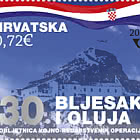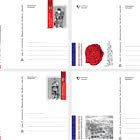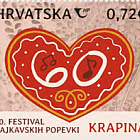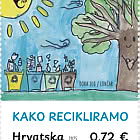Croatian Undersea World III (D)
Twin Fan Worm Bispira Volutacornis
Bispira volutacornisis a species from the Polychaeta group that has not been well researched. This worm-like animal made up of rings grows to the length of around 10 cm and spends its entire life inside a cone it builds using mucus and sediment particles. Only its gills protrude from the cone. They are up to 10 cm long and shaped like two spiral plumes. Gills can be white, orange, brown or purple. They absorb oxygen from the sea water and also collect organic particles and microscopic organisms, such as diatoms, the animal feeds on. This Polychaeta resides in the entire Mediterranean Sea and the eastern part of the north Atlantic.
In the Adriatic Sea they typically reside in shallow protected areas with gravel or Neptune grass at the maximum depth of 10 meters. It can be found individually or in groups of several units.
The copepod crab (Gastrodelphys clausii), described according to the units gathered from the Adriatic Sea, has evolutionally adapted to life exclusive to gills of this Polychaeta. It is around 1.5 mm long. Its diet also includes gills of Polychaeta, but there has been no indication that it has a significant impact on the health of its host. Crabs mostly feed on what the Polychaeta gathers by filtering the sea water. It would not make much sense to harm a Polychaeta because, in case of danger, it immediately retracts its plume into the cone thereby protecting the tiny copepod crabs.
Purple Sea Urchin Sphaerechinus Granularis
The purple sea urchin, Sphaerechinus granularis, inhabits the entire Mediterranean Sea and the eastern part of the Atlantic from the British Islands to the Gulf of Guinea. It lives at depths between the surface to around 100 m, typically on sandy gravel bottoms where it feeds on coralligenous algae and detritus.
Its spikes are short and dull, purple or brown with white tops, or entirely white. The shell is light purple with a diameter of up to 13 cm.
Many types of urchins, including the purple sea urchin, tend to carry small stones, shells or pieces of algae and flowering plants. It is a common belief that females “decorate“ themselves. However, males place various materials on themselves as much as females. The real reason for such behaviour is unknown, but it is assumed that urchins use it to protect themselves from strong light, UV rays in shallows and perhaps even from predators.
We often see them in groups on the sea bottom. As many as 200 units per m2 have been seen. If the reason is breeding, this gathering lasts only for a day or two. However, if they are found in an area with good food, they group for as long as several weeks.
During the daytime, young urchins often hide by burying themselves among small pebbles. This is where they are safe from attacks by spiny starfish (Marthasterias glacialis), their only dangerous predator in the Mediterranean Sea.
In some parts of Italy, France and Spain, where they consider the gonads of the purple sea urchin to be a special delicacy, mankind is still their greatest threat. If they survive spiny starfish gatherings and attacks, they can live to the age of around ten years.
Sea Slug Peltodoris Atromaculata
Peltodoris atromaculatais a slug with a flat oval shape and length of around 10 cm. Its skin has small bumps, and is hard and coarse. It is white in colour with very recognisable dark brown spots that give it its name – Dalmatian snail.
It has two spiral tentacles on the front side of its body that serve as its chemical sensors. Tentacles have up to 25 lamellas increasing the surface for receiving chemical signals brought by the sea water. Tentacles, as well as the gills on the back side of the body, quickly retract in case of danger.
It spends most of its life on a sea sponge, Petrosia ficiformis, that is its only source of food. There can be up to 10 snails on an individual sea sponge. They store toxic compounds produced by the sea sponge making them inedible. Due to the specific colour, predators are well aware that this is a type of food that should be avoided. It is believed that the colour, unusual for the Mediterranean Sea species, repels predators.
This species was considered endemic to the Mediterranean for a long time but it was found in closer areas of the Atlantic, such as the Canary Islands. It is common in the Adriatic, typically in shaded areas, from the surface to the depth of around 40 m.
Eel Eel Helena
Eel helena, eel, is a snake-like predatory fish. It is widespread in the Mediterranean Sea and the east part of the Atlantic Ocean. It grows to the length of 1.5 m and weighs of up to 15 kg. Its maximum lifespan is 15 years. It has thick and mucous skin with no scales so it easily squeezes through sharp rocks, both forward and backward. Just like all eels, it does not have a chest fin making it easy to differentiate from other snake-like fish.
Eel constantly opens and closes its mouth making it appear menacing, but it actually only suctions sea water to its gills. The gill opening is located far from its head and it uses it to expel the sea water it suctions through the mouth.
Eel hunts fish, crabs and cephalopods during the night time. It does not see well so it relies on its sense of smell for hunting.
It is territorial but it gladly shares its hole with the Lysmata seticaudatatype of shrimp that constantly search its skin and mouth looking for parasites and keep it healthy by doing so.
It is interesting to know that no female with well-developed gonads has ever been found in the Adriatic. It is believed that in order to breed, males and females go to the deepest areas of the Adriatic, deeper than 600 m, where they spawn. Larvae in plankton, known as leptocephalus, can be carried by sea currents for as long as a year before they descend to the sea bottom, find their holes and foster their shrimps.
Ante Žuljević, Scientific Associate
Institute of Oceanography
Croatia - Recommended stamp issues
WOPA+ recommended stamp issues
| Avatar - Fire and Ash |
| Issued: 03.12.2025 |
| ›New Zealand |
| 50th Anniversary of the Founding of the 24th November Bar Scout |
| Issued: 24.11.2025 |
| ›Montenegro |
| Krisjanis Valdemars |
| Issued: 02.12.2025 |
| ›Latvia |
| Sign Language - Good |
| Issued: 02.12.2025 |
| ›Bosnia and Herzegovina - Republic of Srpska |
| In Memory of the Fallen and Murdered on October 7, 2023 |
| Issued: 08.10.2025 |
| ›Israel |
| Annual Collection Folder (New York) |
| Issued: 05.12.2025 |
| ›United Nations |
| Year Set |
| Issued: 24.11.2025 |
| ›Isle of Man |
| Shipping in the 17th and 18th Centuries - Peat Shipping |
| Issued: 05.12.2025 |
| ›Netherlands |










































